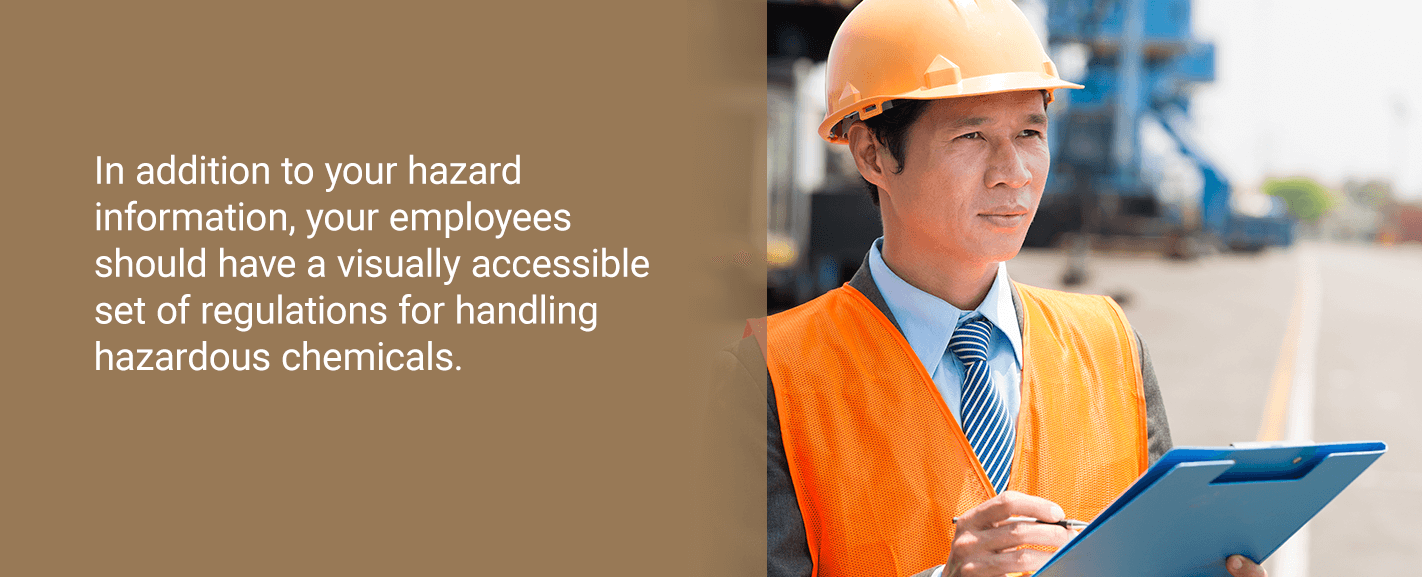How to Handle Hazardous Materials

If you’re a safety professional, you understand the importance of handling hazardous materials or chemicals in your workplace. Exposure to hazardous materials can cause many health complications, from simple skin irritations to long-term illnesses. The risks are significant, and safety professionals must create effective protocols for handling, transporting, and storing hazardous materials.
Neglecting safety concerns can cost your business money. Knowing the procedures and regulations to maintain compliance elevates your workplace safety profile and saves your business from expensive citations and workers’ compensation claims.
What Are Hazardous Materials?
A hazardous material is anything that can harm living beings or the environment by itself or when combined with something else. Hazardous materials can be biological, chemical, physical, or radiological.
Four major agencies define and govern hazardous materials in the U.S.
- The Environmental Protection Agency
- The Occupational Safety and Health Administration
- The U.S. Department of Transportation
- The U.S. Nuclear Regulatory Commission
Though their descriptions of hazardous materials may differ slightly, the goal remains the same — prioritizing safety.
Why Is the Proper Handling of Hazardous Materials Important?
Correctly handling hazardous materials is essential for safety. Employees exposed to these workplace dangers must respect the risks and take safety measures to protect themselves, others, and the environment. Exposure to hazardous materials can result in significant health effects, some of which include the following:
- Nausea and vomiting
- Cancer
- Nervous system disorders
- Chemical burns
- Reproductive defects
- Kidney, lung, and liver disorders
- Skin irritations and headaches
Many people nationwide work with hazardous materials, and respiratory protection and personal protective and lifesaving equipment violations are the fourth and ninth most cited OSHA violations in 2022. Failure to correctly handle and store hazardous materials can result in significant penalties, workers’ comp claims, and potential legal action.
How to Handle and Store Hazardous Materials
If your facility handles and stores hazardous chemicals, you must observe regulations and best practices to prevent accidental exposure or damaged equipment. The rules and guidelines governing your industry can provide valuable guidance for you and your employees. The following steps will help you enhance your organization’s storage and handling practices.
1. Create a HazCom Program
OSHA’s Hazard Communication standard aims to protect workers by providing information on chemical hazards and safety protocols. OSHA mandates Hazard Communication — or HazCom — regulations and encourages organizations to meet the following requirements:
- Written Hazard Communication program: Organizations must create and implement a detailed HazCom program outlining how they communicate essential hazard information and emergency protocols to employees.
- Chemical Inventory: You must identify and document all hazardous chemicals in the workplace and make this information accessible to every employee.
- Safety Data Sheets (SDS): Every chemical in your inventory must have an accompanying SDS, communicating its specific hazards and detailing particular protection measures for the workplace.
- Labels on Chemical Containers: All chemical containers — including secondary and mixing containers — should have labels including hazard information, product identifiers, and pictograms.
- Employee Training: Employers must provide training on workplace chemicals before employees start work and when introducing a new chemical.
2. Label All Hazardous Materials
When someone picks up a hazardous material container, they should know the risks immediately. OSHA HazCom requirements stipulate labeling all chemical containers with the chemical’s name, hazard classification, and appropriate warnings. Ensure there is no opportunity for employees to misinterpret the contents of a container or cabinet, which could lead to accidental exposure.
3. Provide Information and Training
It’s mandatory to train and inform your employees about the hazardous materials they work with. While OSHA outlines a minimum training obligation, you can expand your employees’ training beyond these requirements, giving them the tools to establish adequate procedures and elevate workplace safety.
4. Create a List of Rules and Regulations
In addition to your hazard information, your employees should have a visually accessible set of regulations for handling hazardous chemicals. Fundamental rules include the following:
- Follow all your training and established procedures.
- Maintain caution, paying close attention when working with hazardous chemicals.
- Always use the required PPE and scrutinize it before use. Immediately report any worn or broken PPE to your safety manager.
- Only use chemicals contained or labeled correctly, and report unreadable labels to your supervisor immediately.
- Read all labels and SDSs before using a hazardous material so you’re confident in the procedures and understand the hazards.
- Use materials for their intended purpose only.
- Refrain from eating, drinking, or smoking when using hazardous materials.
- Ensure you know and understand emergency procedures and equipment.
- Wash your hands thoroughly with soap and water after using hazardous chemicals.
- Keep your work area clean to reduce contamination risks.
5. Follow Strict Storage Protocols
Adopt these protocols to align with hazardous material storage best practices:
- Use suitable containers: Only use containers explicitly designed for the material. They should be in good condition, without damage like cracks or leaks.
- Separate incompatible materials: Always store hazardous materials based on compatibility, with compatible materials together so they don’t react with one another. Labeling is vital for the correct storage, so read all labels carefully to avoid compatibility mistakes.
- Designate an area: Choose a designated area far from heat, flames, and sparks. Ensure this area is only accessible to the necessary personnel to prevent exposure.
- Choose the right location: Your storage should be cool, dry, and well-ventilated, keeping chemicals separate from materials that could trigger reactions. It should also be well away from food and drink items to prevent contamination.
- Keep the heavy items on the bottom: Heavier containers can fall through and damage other containers, so keep them stored at the bottom.
- Check that everything is upright: Preventing leaks and spills is essential, so double check all chemical containers are upright.
- Inspect sites periodically: Each industry has different storage requirements. Ensure you adhere to these requirements, check all hazardous areas weekly, and promptly address safety concerns. Maintain the structures and respond to spills and leakages immediately.
6. Use Appropriate Personal Protection Equipment
PPE requirements differ depending on the hazardous materials you’re working with. Ensure you have the correct PPE available for each task.
- Skin protection: Gloves, boots, and face masks
- Respiratory protection: Masks, respirators, and breathing apparatus
- Personal hygiene: Overalls, aprons, hats, and gloves
- Eye protection: Goggles and glasses
- Thermal protection: Overalls, gloves, masks, and boots
- First-aid kits: Based on the hazardous material, the kit contents must support the emergency protocols.
7. Prepare Plans, Records, and Reports
When you use hazardous materials in the workplace, you must keep strict records of:
- Risk assessment details
- Air and environment test results, if required
- Waste analysis and determination
- Employee health monitoring details
- Employee records for anyone who works with a carcinogenic substance
In addition, you must have written plans to address the following:
- Contingencies and emergencies
- Waste minimization
- Training
Handle Hazardous Materials Safely with the National Association of Safety Professionals
Handling hazardous materials is part of a day’s work for many workers across the United States, and organizations need to invest to minimize accidental exposure and expensive citations. NASP is here to walk you through handling, transporting, and storing hazardous materials with a variety of hazardous material focused classroom and online training courses, and an extensive array of safety consulting services.
Contact us today to learn more about NASP’s practical approach to workplace safety.
Purchase Our Hazardous Waste Management Specialist (HMS) Course
Blog Posts
Latest Posts
Related Posts






